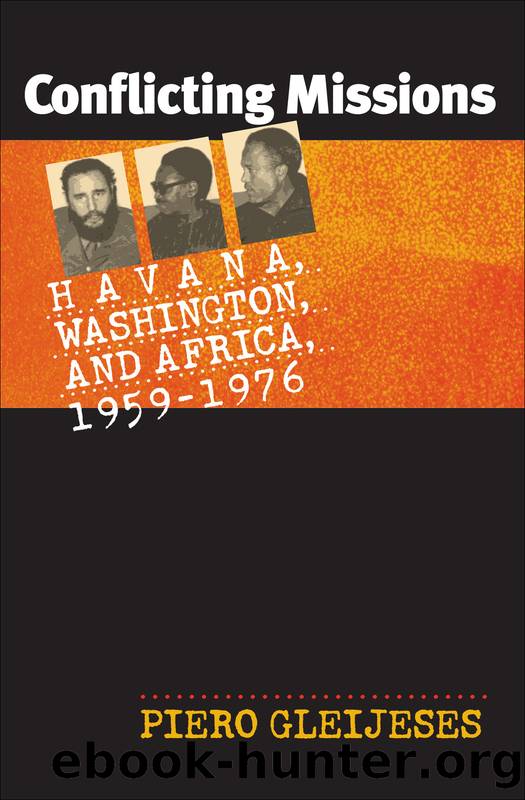Conflicting Missions by Piero Gleijeses

Author:Piero Gleijeses [Gleijeses, Piero]
Language: eng
Format: epub
ISBN: 9780807826478
Publisher: UNC Press
Published: 2002-09-15T05:00:00+00:00
FRIENDS
The United States was in the lead, flanked by Zaire and South Africa. England and France took up the rear. This was the coalition that was forming in the summer of 1975 behind UNITA and the FNLA. âThey are the same, those who yesterday . . . supported Salazar and Caetano, and today are against the MPLA,â Neto remarked.101
By July, Crocker asserts, the British and the French governments had begun âtheir own clandestine assistance programs.â British companies joined in to help UNITA. When Stockwell flew from Lusaka to Silva Porto in Angolaâs central highlands to meet Savimbi in August 1975, he flew in a small Lear jet with a British crew on loan from the British commercial conglomerate Lonrho. Lonrho âwas betting on Savimbi to win the war,â Stockwell remarked. âSpecial access to Angolan minerals would be prize aplenty.â102
France coveted Cabindaâs oil. âThe Cabindan affair puzzles Paris,â Le Monde explained in August 1975, âbecause Brazzaville and Kinshasa, both special friends of France, have contradictory views about the future of the enclave.â103 Paris, however, had already decided to back Kinshasa.104 Not only was Zaire, with all its mineral riches, a far more attractive partner than the Congo, but its friends, too, were more attractive: South Africa, the United States, Roberto, and Savimbi.
Paris, therefore, helped the FNLA and UNITA. When the Portuguese empire collapsed, âthough we were helpless to prevent Mozambique falling victim to Marxism and famine, the least we could do was to try to counter the Soviet and Cuban ascendancy in Angola,â the director of French intelligence, Alexandre de Marenches, wrote. So France sent weapons to Savimbi and, through Mobutu, to Roberto. âI am sorry to say,â Marenches added, âthat there was no coordination between American services and our own.â There was, in fact, a one-sided partnership. âThe CIA briefed the French intelligence service in detail about its Angola program,â Stockwell complained, âwhile the French listened carefully but told the CIA nothing about their own activities in Angola and Cabinda.â In September 1975 Neto told Le Monde, âIt appears that it is Franceâs destiny to help the reactionary forces in Africa.â105
The odd men in this company were the Chinese, who had about 200 military instructors training the FNLA in Zaire by the end of 1974. âThe Chinese recently agreed to continue this assistance until the end of 1975,â the Davis task force noted in June 1975. The following month, Beijing, which had already supplied arms to the FNLA (and, to a lesser degree, to UNITA), acceded to a new request from Roberto and went âout of its way to make sure the supplies were received quickly.â106 Chinaâs assistance was welcomed by U.S. officials, but there was no consultation or coordination between the two governments. Relations between Washington and Beijing, which had blossomed in 1971â72, had lost momentum by 1973â74, and âa certain immobilism and cooling of atmosphereâ had set in because of domestic difficulties in both countries, Chinese dissatisfaction with continuing U.S. ties with Taiwan, and Beijingâs fears that the United States was playing the China card in its pursuit of détente with the Soviet Union.
Download
This site does not store any files on its server. We only index and link to content provided by other sites. Please contact the content providers to delete copyright contents if any and email us, we'll remove relevant links or contents immediately.
| Central Africa | East Africa |
| North Africa | Southern Africa |
| West Africa | Algeria |
| Egypt | Ethiopia |
| Kenya | Nigeria |
| South Africa | Sudan |
| Zimbabwe |
Goodbye Paradise(3455)
Men at Arms by Terry Pratchett(2685)
Tobruk by Peter Fitzsimons(2376)
Arabs by Eugene Rogan(2196)
Pirate Alley by Terry McKnight(2128)
Borders by unknow(2119)
Belonging by Unknown(1732)
It's Our Turn to Eat by Michela Wrong(1593)
The Biafra Story by Frederick Forsyth(1560)
Botswana--Culture Smart! by Michael Main(1484)
The Source by James A. Michener(1459)
A Winter in Arabia by Freya Stark(1447)
Gandhi by Ramachandra Guha(1432)
Coffee: From Bean to Barista by Robert W. Thurston(1420)
Livingstone by Tim Jeal(1394)
The Falls by Unknown(1372)
The Shield and The Sword by Ernle Bradford(1312)
Africa: Altered States, Ordinary Miracles by Richard Dowden(1296)
Egyptian Mythology A Fascinating Guide to Understanding the Gods, Goddesses, Monsters, and Mortals (Greek Mythology - Norse Mythology - Egyptian Mythology) by Matt Clayton(1278)
